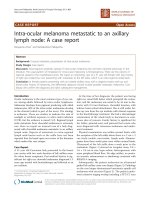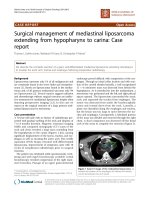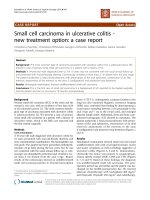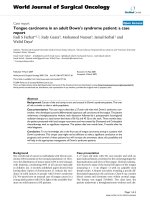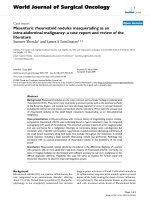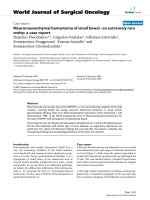báo cáo khoa học: " Branch facial nerve trauma after superficial temporal artery biopsy: a case report" pptx
Bạn đang xem bản rút gọn của tài liệu. Xem và tải ngay bản đầy đủ của tài liệu tại đây (257.22 KB, 3 trang )
CASE REP O R T Open Access
Branch facial nerve trauma after superficial
temporal artery biopsy: a case report
Richard A Rison
Abstract
Introduction: Giant cell arteritis is an emergency requiring prompt diagnosis and treatment. Superficial temporal
artery biopsy is the gold diagnostic standard. Complications are few and infrequent; however, facial nerve injury
has been reported, leaving an untoward cosmetic outcome. This case report is to the best of our knowledge only
the fourth one presented in the available literature so far regarding facial nerve injury from superficial temporal
artery biopsy.
Case presentation: A 73-year-old Caucasian woman presented for neurological evaluation regarding eyebrow and
facial asymmetry after a superficial temporal artery biopsy for presumptive giant cell arteritis-induced cephalalgia.
Conclusion: Damage to branches of the facial nerve may occur after superficial temporal artery biopsy, resulting in
eyebrow droop. Although an uncommon and sparsely reported complication, all clinicians of various specialties
involved in the care of these patients should be aware of this given the gravity of giant cell arteritis and the
widespread use of temporal artery biopsy.
Introduction
Giant cell arteritis (GCA) is a neurologic emergency
requiring prompt diagnosis and treatment. For years,
the gold standard diagnostic test has been superficial
temporal artery biopsy (STAB). This procedure is gener-
ally well tolerated with infrequent complications. Facial
nerve injury is a known but uncommon complication,
with few reported cases.
Case presentation
A 73-year-old Caucasian woman with a one-year history
of headaches and left temporal tenderness develop ed an
elevated erythro cyte sedimentatio n rate. She was started
on prednisone and a few days later underwent a left-
sided STAB as an outpatient. In the recovery room, she
noted difficulty closing her left eye secondary to weak-
ness. She also noted numbness along the left portion of
her face. There were no complaints of blurry or d ouble
vision, difficulty swallowing or slurred speech. She did
not complain of any weakness in her arms or legs. She
did not have vertigo, tinnitus, diminished hearing or
lapses of consciousness. She was tol d at the time that
she may have had an adverse effect from the local an es-
thetic and was discharged home with eye drops.
The patient’ s medical history was remarkable for
hypertension, hype rcholesterolemia, a past transient
ischemic attack, fibromyalgia and gout. She was taking
levothyroxine, simvastatin, duloxetine, lisinopril, hydro-
chlorothiazide, clopidogrel and prednisone.
The patient presented for neurologic evaluation six
weeks after the STAB. General physical examination
revealed a blood pressure in her left arm (sitting posi-
tion) of 110/70 mm Hg with a regular pulse. Her height
was 5’3”, and she weighed 152 lb. There were no carotid
bruits or cardiac murmurs, and her lungs were clear to
auscultation. She had a well-healed scar over the region
where the left STAB had been done. Cranial nerve
examination was remarkable for significant limitation of
left eye closure (her eyelid could not adequately cover
her sclera beneath her pupil). There was also diminished
upward furrowing of her left brow with minimal mild
and slow weakness seen i n the left lower portion of her
face, producing mild asymmetry. The right facial mus-
cles were all completely intact. No facial synkinesis was
witnessed. Facial sensation was intact in a bilateral
Correspondence:
University of Southern California, Keck School of Medicine, Los Angeles
County Medical Center, Los Angeles, California USA; Presbyterian
Intercommunity Hospital, 12401 Washington Blvd., Whittier, California 90602,
USA
Rison Journal of Medical Case Reports 2011, 5:34
/>JOURNAL OF MEDICAL
CASE REPORTS
© 2011 Rison; licensee BioM ed Central Ltd. This is an Open Access article dist ributed under the terms of the Creative Commons
Attribution License ( which permits unrestricted use, distribution, and repro duction in
any medium, provided the original work is properly cited.
V1 through V3 di stribution to light touch and tempera-
ture. Her pupils were round, equal and symmetric to
light. Visual fields were intact, and disc margins were
sharp on funduscopic examination. All ocular move-
ments were intact with conjugate gaze and without nys-
tagmus. All muscles of masticati on were intact. She had
no hearing deficits, and visual inspection of the bilateral
internal auditory canals did not reveal any hemorrhages,
erythema, vesicles or exudates. Her pal ate elevated mid-
line, and her gag reflex was intact. Her bilateral sterno-
cleidomastoid and trapezius muscles all displayed intact
strength, and her tongue protruded midline without any
fasciculations or atrophy. The remainder of the neurolo-
gic examination revealed no focal motor, sensory, coor-
dination, gait or reflex deficits. Her speech and mental
status were both quite intact.
Investigations were significant for a magnetic reso-
nance imaging study with and without contrast that
revealed cerebral ischemic gliosis compatible with the
patient’s ag e without acute intracranial pathology. There
were no abnormalities noted along the course of either
cranial seventh nerve. Her left STAB incision did not
show evidence of thrombus, inflammation or giant cells
and hence was without evidence of temporal arteritis.
Discussion
GCA is a medical emergency characterized by systemic
inflammation and critical ischemia with early neuro-
ophthalmic complications.Itisthemostcommonvas-
culitisseeninWesterncountries involving large- and
medium-sized arteries with a predilection toward the
cranial arterial vasculature. There is a female preponder-
ance with increa sing frequency a s one ages . Permanent
visual loss can occur in up to 20% of patients and is the
best known and most feared complication. STAB
remains the gold standard for diagnosis [1].
STAB is a widely performed procedure with relative
safety. It is usually performed under local anesthesia in
an office or same-da y surgical setting [2]. The incidence
of complications after STAB is quite low, with the
majority of cases being temporary and minor [3]. Com-
plications include incorrect or inadequate tissue sam-
pling, bleeding, hematoma formation if the arterial
ligature slips [4], scarring, infection, wound dehiscence,
and rarely cerebral ischemia after the biopsy when the
temporal artery provides essential collateral circulation
in the case of severe ipsilateral carotid disease [3,5]. The
latter complication of cer ebral ischemia can be clinically
distinguished from branch facial nerve trauma by obser-
vation of d isproportion ally increased facial motor invol-
vement expected in upper motor neuron lesio ns (e.g.,
lower facial weakness).
The surgical technique and anatomy of STAB has
been well described in the literature [6,7], and an addi-
tional complication may be eyebrow droop from damage
to branches of the facial nerve if the incision is taken
too close and parallel to the eyebrow [4]. Although this
may be mentioned in standard STAB consent forms,
therehaveonlybeenthreepriorpublishedreportsof
facial nerve injury after STAB, the last one of which was
almost 10 years ago (Table 1). Slavin [8] and Bhatti and
Taher [9] have published cases of eyebrow droop after
STAB. Bhatti and Goldstein [3] reported on a 75-year-
old woman with presumed GCA who developed fronta-
lis muscle paralysis after the biopsy. Inadvertent direct
injury to the branch facial nerve may occur because the
surgical incision may be in a “danger zone”, an anatomic
area of potential injury in which the branches of the
superficial temporal artery course within the superficial
temporal fascia close to the temporal branches of the
facial nerve that run beneath within a loose alveolar
layer [3]. While in this region, the surgeon must take
particular care not to dissect below the superficial tem-
poral fascia (as may happen in difficult cases) using onl y
gentle blunt maneuvers to separate the subdermal fatty
layer and lose fascial attachments to isolate the superfi-
cial temporal artery [3] . The paucity of repor ted adverse
outcomes, however, attests to the overall general safety
of the standard and commonly used STAB sites. Even
with anatomic variations, STAB still remains a quite
safe procedure.
The mechanism of injury in the presented patient may
have been a local branch facial nerve neuropraxia. Other
possibilities include local hematoma formation (perhaps
precipitated by clopidogrel, which was not held preo-
peratively). Vasculitis as a cause was thought to be less
likely given the negative findings on the biopsy speci-
men. Fortunately, at one year later, the patient had com-
plete resolution of her signs and symptoms without any
adverse cosmetic outcome (making nerve section an
unlikely mechanistic cause). She had no evidence of any
permanent peripheral facial nerve damage.
Given the wide variety of specialties that perform STAB
(dermatologists, ophthalmologists, general surgeons,
vascular surgeons and plastic surgeons) along with the
family practitioners, internists, rheumat ologists and
Table 1 Previously reported cases of branch facial nerve injury after superficial temporal artery biopsy
Slavin (1986) [8] A 55-year-old woman with eyebrow droop after a superficial temporal artery biopsy
Bhatti and Taher (2000) [9] A 63-year-old woman with partial facial paralysis after temporal artery biopsy
Bhatti and Goldstein (2001) [3] A 75-year-old woman with facial nerve injury after superficial temporal artery biopsy
Rison Journal of Medical Case Reports 2011, 5:34
/>Page 2 of 3
neurologists who follow these patients, it behooves all
cli nici ans to be aware of this uncommon outcome, espe-
cially because it seems that complications are underre-
ported in the literature. Having in mind these potential
severe complications, STAB should only be performed by
experienced hands.
Conclusion
GCA and STAB are frequently mu ltidisciplinary entities.
Damage to branches of the facial nerve may o ccur after
STAB. Although an uncommon and sparsely reported
complication, all clinicians of various specialties involved
in the care of these patients should be aware of this
condition given the gravity of GCA and the widespread
use of STAB.
Consent
Written informed consent was obtained from the patient
for publication of this case report. A copy of th e written
consent is available for review by the Editor-in-Chief of
this journal.
Abbreviations
GCA: giant cell arteritis; STAB: superficial temporal artery biopsy.
Authors’ contributions
RAR performed the history and physical (including neurologic) examination
and wrote the entire manuscript.
Competing interests
The author declares that they have no competing interests.
Received: 6 May 2010 Accepted: 26 January 2011
Published: 26 January 2011
References
1. Borg FA, Salter VL, Dasgupta B: Neuro-ophthalmic complications in giant
cell arteritis. Curr Allergy Asthma Rep 2008, 8(4):323-330.
2. Hall S, Hunder GG: Is temporal artery biopsy prudent? Mayo Clin Proc
1984, 59:793-796.
3. Bhatti MT, Goldstein MH: Facial nerve injury following superficial
temporal artery biopsy. Dermatol Surg 2001, 27(1):15-17.
4. Riordan-Eva P, Landau K, O’Day J: Temporal artery biopsy in the
management of giant cell arteritis with neuro-ophthalmic complications.
Br J Ophthalmol 2001, 85(10):1248-1251.
5. Fisher CM: Discussion. Giant cell arteritis (temporal arteritis). In Trans Am
Neurol Assoc Edited by: Schlezinger NS, Schatz NJ 1971, 96:12-15.
6. Albertini JG, Ramsey ML, Marks VJ: Temporal artery biopsy in a
dermatologic practice. Dermatol Surg 1999, 25:501-508.
7. Scott KR, Tse DT, Kronish JW: Temporal artery biopsy technique: a clinico-
anatomic approach. Ophthalmic Surg 1991, 22:519-525.
8. Slavin ML: Brow droop after superficial temporal artery biopsy. Arch
Ophthalmol 1986, 104:1127.
9. Bhatti MT, Taher RM: Partial facial paralysis following temporal artery
biopsy. Eye 2000, 14:918-919.
doi:10.1186/1752-1947-5-34
Cite this article as: Rison: Branch facial nerve trauma after superficial
temporal artery biopsy: a case report. Journal of Medical Case Reports
2011 5:34.
Submit your next manuscript to BioMed Central
and take full advantage of:
• Convenient online submission
• Thorough peer review
• No space constraints or color figure charges
• Immediate publication on acceptance
• Inclusion in PubMed, CAS, Scopus and Google Scholar
• Research which is freely available for redistribution
Submit your manuscript at
www.biomedcentral.com/submit
Rison Journal of Medical Case Reports 2011, 5:34
/>Page 3 of 3

